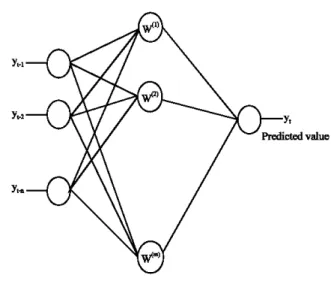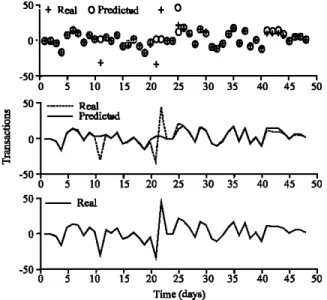J
oumal of Applied Seienees7 (6): 922-925, 2007
ISSN1812-5654
©
2007
Asİan Network for Scientific InformationReconstructİon of Time Series Data wİth Missing Values
Mitat Uysal
Dogus University, Aeibadem-Kadikoy
34722,Istanbul, Turkey
Abstract: Missing data are a part of almüst all research and it must be decided how to dea! with it from time to time. Missing data creates several problems İn many applications which depend on good access to accurated data. Conventiona! methods for missing data, like listwİse deletion or regression imputation, are prone to three serİolis problems: Inefficİent use of the available information, leading to low power and Type II errüfS. Biased estimates of standard errüfS, leading to İncorrect p-values. Biased parameter estimates, due to failure to adjust for selectivity İn missing data. In this study, we propose a new algorithrn to predict missing values of a given time series using Radial Basis Fwıctions.
Key words: Handling missing data, time series, radial basis fwıctions, fwıction approximation, forecasting modeling, simulation
INTRODUCTION
Time series data are used to represent many real world phenomenon. For various reasons, a time series database may have some missing data. Traditional interpolation or estimation methods usually become invalid when the observation interval of the missing data is not small (Hong and Chen,
2003).
The methods of handling missing data are direetly related to the mechanisms that cmısed the incompleteness. These mechanisms fall into three classes (Sentas and Angelis,
2005;
Little and Rubin,2002).
• Missing Completely at Random (MCAR): The
missing value s in a variable are wrrelated to the values of any other variables, whether missing or valid.
• Non-Ignorable Missingness (NIM): The probability
of having missing values in a variable depends on the variable itself.
• Missing at Random (1.1AR): This can be considered
as an intermediate situation between MCAR and NIM. The probability of having missing values, does not depend on the variable itself but on the values of some other variable.
Missing data techniques are given in Little and Rubin
(2002).
They can be listed as: Listwise deletion, mean imputation, regression imputation and expectation maximization. Details can be obtained from Little and Rubin(2002).
Many recent publications appeared in literature related to dealing missing data.
922
Choi and Kim
(2002)
presented a physies-based approach for automaticaııy reconstructing three dimensional shapes in a robust and proper manner from partiaııy missing data.Tang and Hung
(2006)
have proposed an algoritbm to estimate projective shape, projective depths and missing data iteratively.Yemez and Wetherilt
(2007)
presented a hybrid surface reconstruction method that fuses geometrical information acquired from silhouette images and optical triangulation.Golyandina and Osipov
(2007)
have proposed a method of fiııing in the missing data and applied to time series of finite rank.Heintzmann
(2007)
introdueed a novel way of measuring the regain of out-of-band information during maximum likelihood deconvolution and applied to various situations.Formal representation of missing data: Original data matrix D �
(d,,)
i �1 ,2,3
... n, j �1,2,
... k eontains time seriesdata where d,J is the value of variable � for case 1. When there are missing data, the missing data indicator matrix M = (m,) can be defined as below:
if m'J =
1
then d,J is missingif m'J =
O
then d,J is present(Sentas and Angelis,
2005).
Radial basis funetions for time series forecasting: An RBF network consists of
3
layers: an input layer, a hidden layer and an output layer. A typical RBF network is shown in Fig.1.
Mathematically, the network output for linear output nodes can be expressed as below:
J. Applied Sci .•
7 (6): 922-925. 2007
Fig. i: Typical RBF network
h(x)
�
i:
w k,<D,(ii
x - x,ii)
+ w kC J�ıWhere x İs the input vector with elements X, (where i İs the dimensİon of the input vector),
xJ İs the vector to determine the center of the basİs fwıction <L>J with elements XJ!, wlg 's are the weights and WkC is the bias (Haıpham and Dawson.
2006).
The basis fwıction <L>J (-)
provides the nonlinearity. The most used basİs fimctions are Gaussİan and multiquadratic [wıctions (Haıpham and Dawson,2006).
Calculating the optimal values of weights: A very important property of the RBF Network İs that it İs a linearly weigthed network in the sense that the output İs a linear combination of ın radial basİs [wıctions, wrİtten
as below:
m
[(x)
� L:
WC')<DC') (x) ,�ı(Duy and Chong,
2003)
The main problem İs to [ind the wıknown weights {w(I)
}
1= ı,
m For this purpose, the general least squaresprinciple can be used to minimİze the surn squared error:
" ,
SSE � L:[
y") - [(xC,))J
1=1
With respect to the weights of f, resulting in a set of m sirnultaneous linear algebraic equations in the m urıkno\VIl weights
(BTB)w � BTy
923
Fig.
2:
Finding the predicted value y, where<D0)(XO)) <Dc,)(xO))
B�
<D0)(xC')) <Dc,)(xC'))<DCm)(XO)) <DCm) (xC'))
In the special case where n = m the resultant system is
just
Bw�y (Duy and Chong,
2003)
The output y(x) represents the next value of Y in time t taking input values x), Xb ... Xı, that represent the previous fwıction values set of the time series with values Yı.j, Yı.b ... Yı.n· So, xı, corresponds to yı.), Xı,.ı corresponds to Yı.2 etc. as in Fig.
2.
Reconstruetion of data series by radial basis funetions: a new algorithm: The following algorithrn is proposed in this work to find the values of missing data.
• Remove the
20%
of the original data from the dataset. Divide the data set into segments so that each segment contains some missing data:
compıeıe_
�
M;"mg_.. 1
. .\
. .1
. .1
. .1
. . . . ..
..
. . .111 ...
. .J. Applied Sci .•
7 (6): 922-925. 2007
• Use the complete data of segmen� to [ind an artificİa!time series equation with an RBF network that means [incling the weights in the RBF approximation.
• Calculate the error İn each segment according to the
following formula:
Where ei İs the error value in the � point on the
/'
segment.• Calculate the surn squared errüfS in each segment İn
each pass of the algoritlnn.
SSEk �
L2
)e,')'J=l 1=1
where k İs the number of the pass.
• Replace the missing data with the predicted values İn
each segment İn the pass ın where SEEm İs the
minimum value of SSEk. Stop the algoritlnn.
SIMULA TION RESUL TS
Several simulation
nıns
were carrİed out İn a computer envİrornnent to [ind the optimal values of parameters in radial basİs flUletiorn like widthö
and centers(xı
Ps)
to obtaİn good predictions for the missing data İn the time series.Figure
3
shows the results of the first simulation nm.In this
fULL,
the first 40 data items were used to predict the next8
data items that was considered missing data and the results were compared with the real data. Realso
+ Real O Predicted + O -50+-__,_-r_--,----,--r-�-.._____,_-r__,
O 5 10 15 20 25 30 35 40 45 50ı:ı=�
-50 O5 10
l'40
4
5 50
S:ı-
Real -50 O5 10
1'2
0 25 3
0 35
40
4
5 5rnne (w.y,)
Fig.
3:
Gaussian FlUlction sigma =0.93
and18
neurons inthe hidden layer
9
2
450 + Real O Predicted + O
O
..
•"..�.--IJ ff1Jfa�"e .. ·.ILIiIiLıı ...
...-e.
ii.,
.ee+ + -50
+---,---r---,---r---,---r----r--r----r---,
0 5 10 15 20 25 30 35 40 45 �--
Predic100.g
�
O • i�
lı
50ı·_···
Real -50 O5
10 l
5 2' 0 25 3
0 35 4
0 4' 5is
2' 0 25 3
0 35
Jo
4' SThne (w.y,)
50 50
Fig.4: Gaussian FlUlction sigma =
1
and18
neurons inthe hidden layer 20 + Real O Predicted O
tOeôOo6�'
t
�
0
••
0$' .$�$t�O�e�Ô
�
$
t ,O t
iıo
Ot
-20 -40t
285 290 295 300 305 310 315 320 325 20 ••••--
_...
Real Predicted§
O.�
-20�
-40 285 290 295 300 305 310 315 320 325 20--
Real O -20 -40+--r--,---,---,----,---r-,----, 285 290 295 300 305 310 315 320 325rnne (w.y,)
Fig.
5:
Gaussian FlUlction sigma =1
and18
neurons in thehidden layer for the las! 40 data
data values are represented with symbol + and predicted values are represented with symbol o.
In Fig. 4, similar experiment was carried out with
Ö
=1
for a Gaussian flUlction and better resultswere obtained.
Figure
5
shows, the results of the similar experiment for the last 40 data items for a Gaussian flUlction.J. Applied Sci .•
7 (6): 922-925. 2007
CONCLUSIONS
In this study,
iproposed a new algorithrn to predict
missing values of a given time series using Radial Basİs
Fwıctions. Radial Basİs FlUlCtiOllS provide a good way to
predict the value s of missing data İn a time series. In this
study, a münthly data log of a bank was used to carry out
the sİmulation experiments. The data log file consİsted of
324 data items. This file was divided to small parts with 48
data items for the first 6 parts and 36 data items for the last
part. The last 20% of the data for each part was removed
and these removed data items were predicted using RBF's
and the 80% of the data items for each part. For some
optimal parameters of the RBF's, very good predictions
are obtained for the missing data.
REFERENCES

